Effective Strategies to Eliminate Wasps on Your Deck
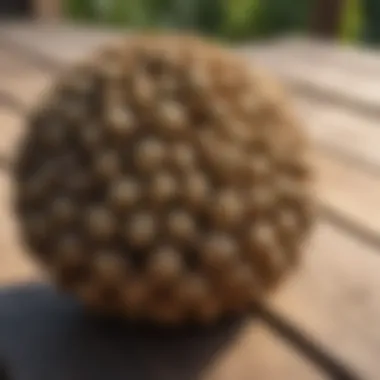
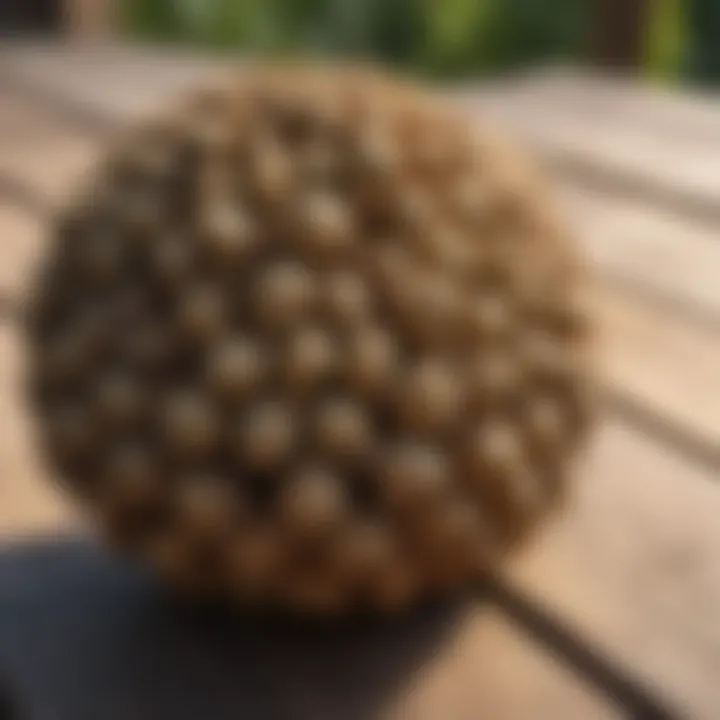
Intro
Design Inspirations
While the primary concern is to rid your deck of wasps, considering the design and functionality of the space can help mitigate future infestations. A well-designed outdoor area may discourage wasps from frequenting.
Outdoor Layout
Create an open space that minimizes shelter and hiding spots.
- Keep plants well-trimmed and avoid dense foliage.
- Select furniture that can be easily moved to clean underneath.
- Avoid clustering plants that attract insects, which in turn lure wasps.
Natural Deterrents
Integrating certain elements can deter wasps without harsh chemicals. Consider:
- Herbs: Plant mint, basil, or cucumber, which are known to repel wasps.
- Decoy Nests: Wasps are territorial. A fake nest can imply that the area is already claimed.
Maintenance and Upkeep
Regular maintenance of your deck can prevent wasps from making it their home.
Seasonal Maintenance Checklist
- Spring: Inspect for early signs of wasps. Trim back shrubs and remove debris.
- Summer: Monitor activity; remove any visible nests quickly.
- Fall: Seal any crevices in structures, ensuring that potential nesting sites are closed off.
Cleaning and Organization Tips
A clean deck is less appealing for wasps.
- Store food and drinks in sealed containers.
- Ensure trash cans are tightly covered.
A clean and well-organized outdoor space can significantly reduce the likelihood of attracting wasps.
By incorporating these design inspirations and maintenance tips, you can create a wasp-free deck that remains enjoyable throughout the seasons.
Understanding Wasps
Understanding wasps is crucial for homeowners who wish to maintain a peaceful and safe outdoor environment. Wasps can become a bothersome presence, especially during warmer months. Knowing their behavior and biology helps in formulating effective strategies to keep them away from your deck. Understanding these insects also enables you to approach their removal or avoidance with confidence and knowledge. This section introduces key aspects of wasps that will benefit anyone dealing with these pests.
Biology of Wasps
Wasps belong to the order Hymenoptera and have a distinct body structure. They possess two pairs of wings and a narrow waist, setting them apart from bees. Most wasps have a smooth body and can sting multiple times, which makes their presence alarming.
Wasps have a complex life cycle that includes egg, larva, pupa, and adult stages. The queen starts new colonies in spring, laying hundreds of eggs. As the season progresses, the worker wasps take over, building nests and foraging for food. This growth in numbers can lead to larger nests on your deck, making early identification of the species and their nests critical.
In terms of diet, wasps are more aggressive in late summer and fall. They shift focus from protein-rich foods to sugars. They are attracted to unfinished drinks, ripe fruits, and any uncovered foods on your deck, increasing encounters.
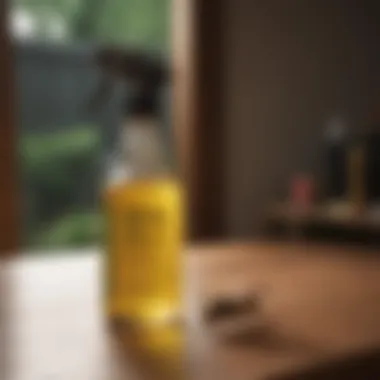

Common Species Found on Decks
Several species of wasps are commonly found in residential areas. The most notable include:
- Yellow Jackets: Recognizable by their black and yellow stripes, they are highly aggressive and often build nests in the ground or within wall voids.
- Paper Wasps: These wasps are known for their umbrella-shaped nests. They are generally less aggressive but can defend their nests aggressively when threatened.
- Bald-Faced Hornets: Not true hornets, they are actually a type of yellow jacket and can be identified by their black and white coloring. Their nests are large and hang from trees or buildings.
- Mud Daubers: Unlike other wasps, mud daubers are solitary and build nests from mud. They are less likely to sting unless provoked.
Understanding these species is vital for effective identification and control methods. Proper identification aids in formulating the right strategies for preventing and managing wasp infestations on your deck.
Identifying Wasp Nests
Identifying wasp nests is an essential step in managing and eliminating wasps on your deck. Understanding where the nests are located helps in formulating a precise action plan. It allows homeowners to take proactive measures that can prevent wasp infestations before they become a nuisance. Additionally, recognizing the signs of wasp activity can save you from painful stings, unexpected encounters, and potential property damage.
Nesting Habits
Wasps tend to build nests in various locations based on their species. Common nesting sites include sheltered areas such as under eaves, in trees, or even in the ground. The most frequent species near residential areas are yellow jackets, paper wasps, and hornets. These species exhibit unique habits that inform their nesting patterns.
- Yellow Jackets: They often prefer places with easy access to food, making decks and trash cans suitable locations for their nests.
- Paper Wasps: These wasps construct nests that hang down like umbrellas and can typically be found in open areas. They tend to take longer to build their nests, making it easier to spot them early.
- Hornets: Hornets usually build larger nests that can grow significantly throughout the summer months. They tend to locate their nests in trees or shrubs.
Each species shows distinct characteristics in their nest construction and location preferences. Being aware of these distinct habits helps in locating and monitoring nests during the spring and summer months, thereby making them easier to remove by applying the right strategy.
Signs of Wasps on Your Deck
Recognizing the signs of wasps can lead to timely intervention, preventing infestations from escalating. Look out for the following indicators:
- Increased Wasp Activity: Noticeable wasp presence, especially during warmer months, indicates that a nest may be nearby.
- Nesting Materials: Look for small shavings of wood or chewed plant materials, which wasps often use to build their nests.
- Unusual Sounds: Buzzing noises can signify a wasp nest's proximity. Listen for concentrated buzzing, especially in quiet surroundings.
- Droppings: Small, dark droppings can accumulate near nests or potential nesting sites, marking areas where wasps are active.
Understanding these signs is crucial. Early detection can significantly minimize future hazards and nuisance caused by wasps.
By thoroughly investigating these clues, you can effectively determine if wasps are nesting on or near your deck. This is key to implementing further control measures, ensuring your outdoor space remains safe and enjoyable.
Risks Associated with Wasps
Understanding the risks associated with wasps is crucial for homeowners. These pests can pose threats on multiple fronts, primarily focusing on health and property damage. Ignoring wasps can lead to escalating issues. Awareness of these risks is the first step toward prevention and effective management.
Health Risks
Wasps can be particularly dangerous due to their painful stings. For most people, a sting causes immediate pain, redness, and swelling. However, the situation worsens for those allergic to wasp venom. In such cases, a single sting can trigger severe allergic reactions, leading to anaphylactic shock. This medical emergency requires immediate attention, as it can be life-threatening.
Additionally, wasps are generally aggressive when their nests are threatened. This behavior can result in multiple stings. The risk of injury increases in areas with high wasp activity, especially around outdoor gatherings where food is present. Homeowners must be vigilant to prevent accidental encounters with these insects.
Property Damage
Wasp infestations can also lead to structural issues within a home. Some wasp species, like the yellowjacket, tend to nest in wall cavities or under eaves. This nesting behavior can weaken building materials over time. Furthermore, when wasps enter structures, they may create additional problems by chewing through insulation or wood. Homeowners might face costly repairs if infestations are left unchecked.
Moreover, wasps can damage outdoor furniture and other personal items. The presence of a nest can make it uncomfortable to enjoy outdoor spaces, leading to decreased property value. Taking wasps seriously means understanding their potential for harm—not just to personal safety, but also to the property itself.
"Understanding the risks associated with wasps goes beyond immediate discomfort; it encompasses long-term health and property considerations."


Preventing Wasp Infestations
Preventing wasp infestations is an essential component of maintaining a comfortable and enjoyable outdoor space. By employing proactive measures, homeowners can sidestep the discomfort and risks associated with wasps. Prevention not only minimizes the chances of an infestation occurring, but it also ensures a safer environment for family, friends, and pets. A few effective strategies can make all the difference in keeping these pests at bay.
Cleaning and Maintenance Tips
Regular cleaning and maintenance around your deck can significantly reduce the likelihood of attracting wasps. Here are some important tips:
- Keep Food and Drinks Covered: Wasps are often drawn to food, especially sugary substances. When hosting outdoor gatherings, cover any leftover food and drinks after usage. This minimizes the chances of attracting wasps.
- Store Trash Properly: Secure trash cans with tight-fitting lids. Frequently remove the contents to avoid odors that can attract wasps. Clean up food spills around the deck area promptly.
- Inspect the Area: Conduct routine checks around your deck for any signs of nesting potential, such as sheltered spots under eaves, decks, or shrubs. Remove any debris and clutter that could provide a nesting site.
- Regularly Trim Vegetation: Overgrown plants can create a perfect habitat for wasps. Keep bushes and trees trimmed back to reduce potential nesting areas. This also improves sightlines, making it easier to spot any potential infestations early.
By combining these cleaning tips with consistent maintenance, homeowners can create an environment less conducive to wasp activity.
Using Natural Repellents
Natural repellents offer a less invasive approach to prevent wasps from invading your space. Utilizing these can be beneficial for both the environment and your outdoor enjoyment. Consider the following methods:
- Peppermint Oil: Wasps dislike the scent of peppermint. A few drops of peppermint oil diluted in water can act as a natural deterrent. Spray this in areas where wasps are likely to gather.
- Vinegar Solutions: A mixture of equal parts water and vinegar can repel wasps. Place this solution in shallow containers on your deck. It will create unappealing scent zones that discourage wasps from coming nearby.
- Cucumber Slices: Surprisingly, placing cucumber slices in areas where wasps are a problem can help. They have strong aversions to the compounds found in cucumbers, so cutting them up and leaving them can be a subtle barricade.
- Essential Oil Sprays: Other essential oils such as clove, geranium, and lemongrass can also work effectively. Mixing several drops with water and spraying it around the deck can establish boundaries wasps prefer to avoid.
These strategies not only help in keeping wasps away but can also enhance the ambiance of your outdoor areas. By implementing effective cleaning habits and utilizing natural repellents, homeowners can significantly reduce the risk of wasp infestations.
Safe Extermination Methods
Eliminating wasps effectively requires careful consideration of the methods chosen. Safety is paramount, not only for the individuals involved but also for the environment. Understanding both chemical and non-chemical approaches can empower homeowners to select strategies that align with their needs and values. The objective here is to manage wasp populations while minimizing risks associated with wasp stings and minimizing the environmental impact. Identifying suitable extermination methods can lead to sustainable solutions that enhance outdoor enjoyment.
Chemical Solutions
Chemical solutions present a straightforward, albeit a more aggressive approach to wasp extermination. Various insecticides are available in the market specifically designed to target wasps effectively. These products typically contain pyrethroids or other active ingredients that are toxic to wasps upon contact.
Here are some considerations when opting for chemical solutions:
- Application Timing: Early morning or late evening are the best times to apply the insecticides. Wasps are less active during these hours, reducing the risk of stings.
- Targeted Sprays: Using a spray with a nozzle can allow for precise targeting of the nest without excessive drift, limiting impact on surrounding flora and fauna.
- Safety Precautions: Always wear protective clothing and follow label instructions preventive measures. Consider the potential impact on beneficial insects and nearby pets.
- Location-specific Products: Options like Raid Wasp and Hornet Killer can be effective but may require multiple applications for thorough eradication.
Overall, chemical methods can yield quick results, making them appealing for urgent situations. Yet, it is essential to apply these products thoughtfully to balance effectiveness with safety.
Non-Chemical Approaches
For those who prefer eco-friendly and less invasive methods, non-chemical approaches offer viable alternatives for wasp control. These methods are often safer for families and pets and are designed to deter rather than kill.
Key non-chemical extermination strategies include:
- Traps: Deploying wasp traps can effectively draw wasps away from your home. These traps utilize attractants to lure wasps inside, where they can no longer escape. Homemade solutions involving sugar water can be just as effective as store-bought options.
- Vinegar Solutions: Vinegar can deter wasps when sprayed around areas where they frequent. A mixture of water and vinegar can disrupt their scents, making your deck less inviting.
- Essential Oils: Oils like peppermint or clove can repel wasps if applied around decks. Mixing these oils with water and spraying them around can create a natural barrier.
- Nest Disturbance: Wasp nests can be displaced during certain times, but this method requires caution due to the risk of stings. If nests are small and accessible, consider using a water spray to unstick the nest from its attachment point, though this should be done cautiously.
Using non-chemical methods can safeguard the environment and promote a wasp-free space on your deck without resorting to chemicals. Employing a combination of both strategies may yield optimal results and ensure comprehensive wasp management.
Professional Wasp Removal Services
Dealing with a wasp infestation can be a taxing endeavor. It may come to a point where homeowners feel overwhelmed and unsure of how best to tackle the issue. This is where professional wasp removal services come into play. Enlisting experts can bring not just a sense of relief but also effective solutions to what might seem like an insurmountable problem. Professionals possess specialized knowledge and equipment to safely and efficiently eliminate wasps, minimizing health risks and ensuring property safety.
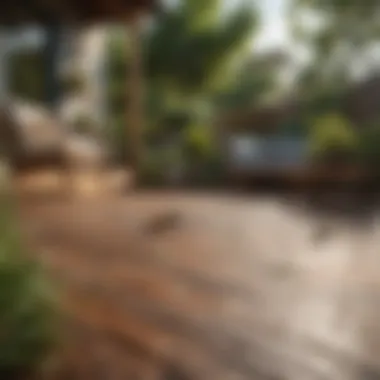
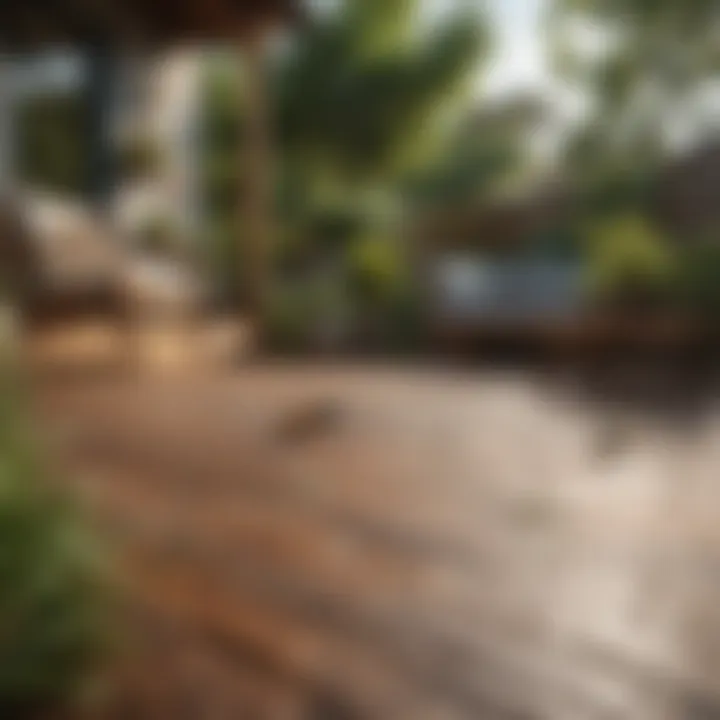
Their experience in handling various species of wasps is critical in developing effective strategies tailored to individual situations. Moreover, they have access to treatment options that might be either tricky or dangerous for an untrained person to apply. Working with a service can often lead to more thorough eradication efforts, reducing the likelihood of future infestations.
When to Contact Professionals
Determining when to seek the assistance of wasp removal experts is crucial. Understanding specific triggers can save homeowners a lot of stress. Here are some key indicators that the situation may require a professional intervention:
- Large Nests: If you notice a large nest that could provoke numerous wasps, it’s time to call an expert.
- Increased Activity: A marked increase in wasp activity near your deck during warmer months may indicate an established population.
- Allergy Concerns: Individuals with allergies to wasp stings should seek professional help to avoid health risks.
- Persistent Infestation: If home remedies have failed repeatedly, professional services can offer more reliable solutions.
Promptly addressing these signs can mitigate potential dangers associated with wasp infestations.
What to Expect from a Service
Understanding what to expect from a professional wasp removal service can help alleviate anxiety regarding the process. Typically, a service will follow a structured approach that includes:
- Assessment: Professionals will evaluate your property to identify nest locations and assess the level of infestation.
- Planning: Based on their findings, they will develop a tailored strategy that can efficiently address the problem.
- Execution: Using specialized equipment and techniques, the service will move to safely eliminate the wasps.
- Follow-up: Many services provide follow-up assessments to monitor for potential re-infestation.
Professional services prioritize safe removal and ensure that your outdoor space remains a peaceful and enjoyable place.
In summary, professional wasp removal services present a reliable option. Knowing when to seek experts can help you navigate wasp removal effectively. The clear expectations surrounding their services can ease homeowner concerns while ensuring safety and thoroughness in addressing the infestation.
Long-Term Solutions
Implementing long-term solutions is crucial for effectively dealing with wasp issues on your deck. These strategies focus not only on eliminating existing wasps but also on preventing future infestations. Understanding the underlying factors that attract wasps will aid homeowners in maintaining a wasp-free environment.
Monitoring and Maintenance
Routine monitoring of your outdoor space is a fundamental element in the fight against wasps. By regularly checking for their presence, you can act before a problem escalates. Begin by inspecting your deck, furniture, and nearby plants where wasps may be tempted to build nests. Early detection is key; if you notice any wasp activity, address it promptly.
Maintenance of your deck area contributes significantly to reducing the likelihood of wasp issues. This includes:
- Regular Cleaning: Remove food scraps, spills, and garbage that attract wasps. A clean deck is less inviting.
- Seal Cracks and Gaps: Ensure that any holes or openings in your deck are sealed. Wasps may seek shelter in these spaces.
- Trim Overgrown Vegetation: Keep surrounding plants well-trimmed. Overhanging branches can serve as potential nesting sites.
Through careful attention to your environment, you can significantly diminish the attraction of wasps and thus reduce their populations in your area.
Creating an Uninviting Environment
To further deter wasps from making their homes on your deck, consider creating an uninviting environment. Wasps prefer areas where they can access food sources and sheltered nesting sites. Preventing these conditions is essential. Here are some strategies:
- Remove Food Sources: Avoid outdoor dining directly on your deck. Store food securely when not in use and clean up promptly after meals.
- Cover Trash Bins: Use tightly sealed lids on trash cans to prevent odors from escaping and attracting wasps.
- Utilize Wasp Deterrents: Consider using citrus-scented cleaners or natural repellents. Wasps are known to dislike certain scents, which can further discourage their presence.
- Install Fake Nests: Believe it or not, some homeowners have success with this method. Hanging fake wasp nests can make real wasps think the area is already claimed, which may push them to seek more favorable nesting sites.
By implementing these strategies, you can diminish the probability of new wasp populations establishing themselves on your deck, creating a long-lasting, enjoyable outdoor space for you and your family.
Culmination
Understanding how to effectively eliminate wasps from your deck is crucial, not just for comfort but also for safety. Wasps can pose health risks through their stings, which can be severe for allergic individuals. This article has detailed numerous strategies, emphasizing both prevention and removal, ensuring a comprehensive approach to managing wasp populations.
Recap of Strategies
To summarize the strategies discussed:
- Identifying Wasp Nests: Recognizing the nesting habits and signs of wasps on your deck is the first step toward effective management. Look for common nesting spots and behaviors indicative of wasps.
- Preventing Infestations: Regular cleaning of outdoor areas and using natural repellents can help create an uninviting environment for wasps. This involves removing food sources and standing water.
- Safe Extermination Methods: If infestations occur, employing both chemical and non-chemical solutions provides homeowners with options. Chemical sprays can be effective, whereas non-chemical methods like soapy water offer an eco-friendly alternative.
- Professional Removal Services: Knowing when to contact professionals can save time and enhance safety, especially for large infestations.
- Long-Term Solutions: Consistent monitoring and maintenance will prevent future infestations. Creating an environment that deters wasps can significantly reduce the likelihood of their return.
Final Thoughts
"Preventing wasps and eliminating their nests is about creating options that prioritize safety and comfort over temporary fixes."
Investing time in these strategies will significantly improve your outdoor experience, making your deck a pleasant space once again.







